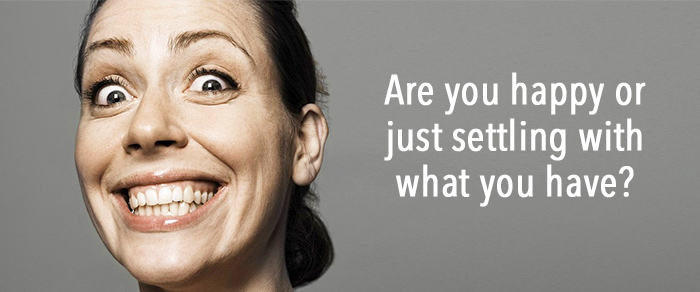
It can be surprisingly hard to tell the difference
There are times when you just know that you’re happy. You get that rush of excitement, a thrill, or your heart beats a million times a minute.
But what about the other end of the spectrum? You know, that mellow and soothing feeling. The feeling that everything is in its place and you can just sit back and relax.
How do you know that your life is in order, versus simply convincing yourself that everything is okay?
It’s hard to say for sure, but I believe there are tell-tale signs. Signs that, if you look closely enough, are indicators that it’s time for a change.
For instance, observe the way you communicate with yourself. Self-talk is a method we commonly use to debrief ourselves after a difficult situation, to get us through obstacles, or to evaluate how we feel. It can also be used to console ourselves when things aren’t right.
You might catch yourself saying different things depending on whether you’re truly content or just complacent.
When you feel content, you use phrases such as:
- “I’m so relieved.”
- “I love waking up every morning.”
- “Things are as they should be.”
On the other hand, if you’re feeling complacent, you might tell yourself phrases such as:
- “It’s okay if I couldn’t achieve what I wanted.”
- “Maybe someday.”
- “You can’t have everything.”
While the latter phrases may be true, they’re also blanket statements for dissatisfaction. Even if things look fine on the surface, it feels like something is not quite right, or missing.
Let’s start with being content. What does it mean to be content? It could mean you’re happy with the situation you are in right now. Or, you might be working towards something, but you’re enjoying the process.
Complacent, on the other hand, means that you’re not really making the most out of what you have.
A car on a journey
Think of being content versus complacent as similar to two brand new cars. The car that is content is driven on a road trip. It takes periodic rests but it gets full usage and sees progression as it travels.
A complacent car, on the other hand, just sits in the garage. It never gets used, so after a while it becomes the norm for the car to just stay in one spot. While the car doesn’t need to be refuelled or fixed, the car hasn’t done anything either. The complacent car is an example of wasted potential, as its purpose is never realised.
Which one would you rather be?
Jeff Bezos, founder and CEO of Amazon, says his decision to leave his high-salaried finance job to start Amazon was very easy. In what he calls the “regret minimisation framework”, he imagines himself at age 80.
At that age, he wants to have looked back at his life and lived with as few regrets as possible. He knew that if he didn’t go ahead and try working on his startup idea, even if it resulted in failure, it would be a lifelong regret.
Though it might be comfortable to stay in one spot for the time-being, most of us end up regretting the things we don’t do, as opposed to whether or not we succeeded.
Time to change
Imagine this scenario. You decide you want to exercise more often. You envision yourself jogging and breaking out a sweat, but you just can’t get yourself to do anything about it.
Every time the idea comes up, you tell yourself that it can wait until later. Your surroundings feel too comfortable to leave, and you don’t feel a sense of urgency to do anything.
You start to notice the excuses you come up with. Things like: “I can do it later.” Or wait until a perfect situation pops up.
These excuses are a way of being complacent. You know you could go out for a run anytime you want to, but you’re comfortable just staying put. Eventually, you’ll have to say: “if I want something done, I need to plan for it.”
It’s not enough to just think something is worth doing. You need to ask myself what you can do, today, to bring change in your life.
How to implement change
In order to improve, it’s important to know where you are in your progress. The first step is to recognise what you have. Even if you’re not where you want to be, there are many things to be grateful for – whether it’s good health, relationships, or even just being able to enjoy a nice day.
The next step is to see what you want to accomplish. Maybe you want to exercise, travel more, or learn a new skill. Once you recognise this, you can map out the steps you intend to take in order to improve each day.
Do something that scares you, something that is out of your usual pattern. Whether it’s sending an email to someone you don’t know, or pulling out a map and planning where you want to travel.
You can be content and embrace change at the same time
When you first start something new, you might feel uncomfortable. But at the same time, you will start feeling happy. Happy that you’re doing something that you really want to, even if it means getting adjusted to the process. It might scare you a little, and that’s a good thing.
Why?
Because living up to your full potential is about doing things that are terrifying. It means taking risks. Inevitably, it means accepting that pain, discomfort and rejection are just a part of the process.
Being content isn’t simply about being satisfied where you are. It’s also enjoying the process you take to reach your potential, with all the bumps along the way.
As Tony Robbins says:
“The real purpose of a goal is that in the pursuit of it you become something more. Getting what you want won’t make you happy – it’s only by becoming who you need to be that you will achieve joy and fulfilment.”

